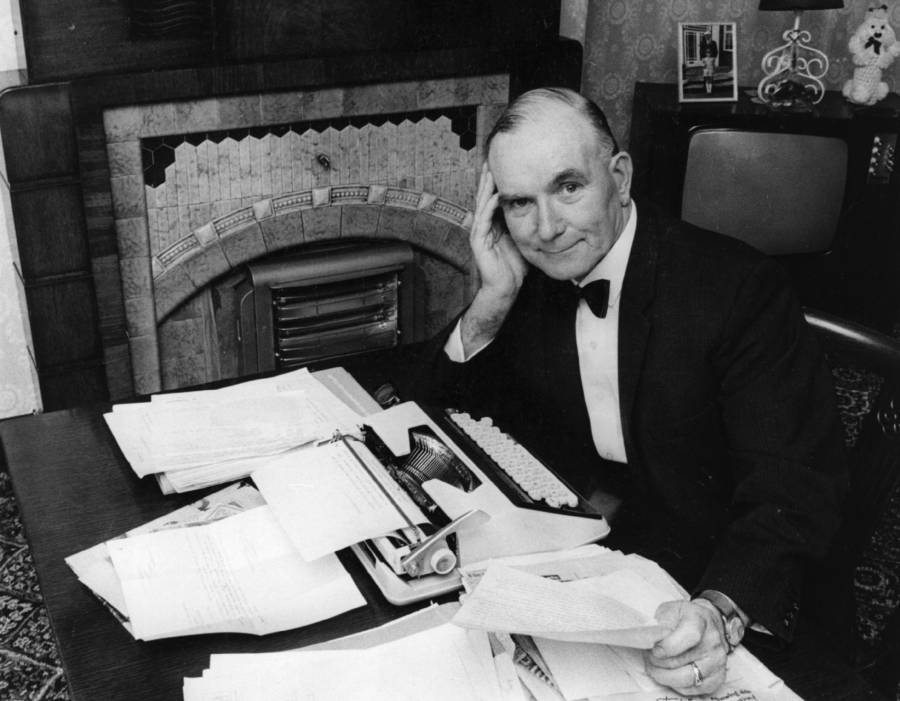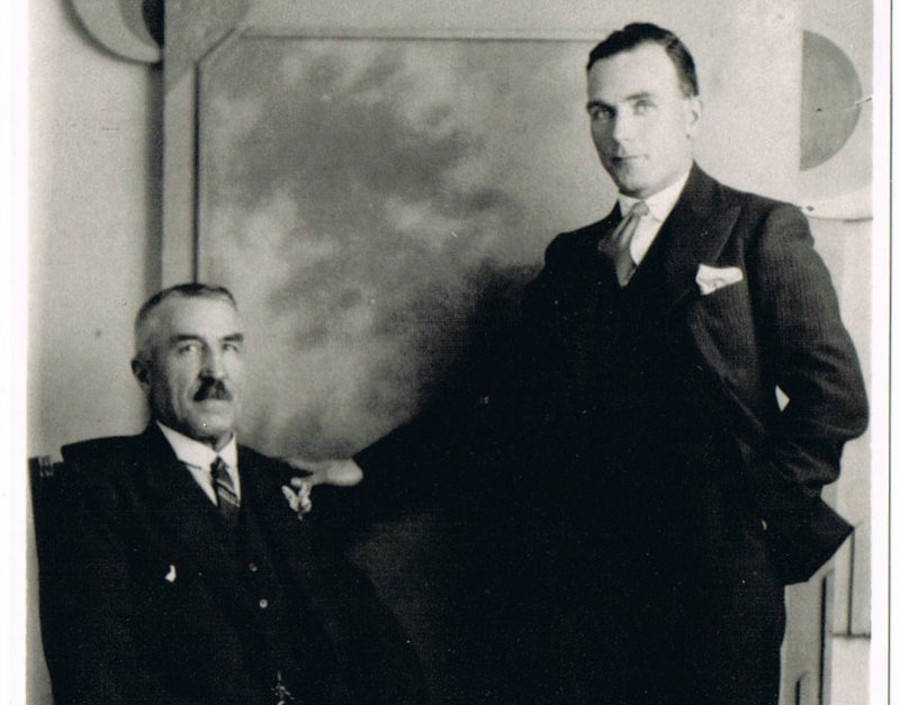Throughout the 1940s and '50s, British hangman Albert Pierrepoint made a career out of killing everyone from infamous serial murderers to Nazi war criminals.

Ian Tyas/Getty ImagesAlbert Pierrepoint
On July 15, 1953, notorious British serial killer John Christie was about to be executed at London’s Pentonville Prison. Immediately before he was to be hanged, Christie, his hands tied behind his back, complained that his nose itched. The executioner then leaned in and told Christie, “It won’t bother you for long.”
That executioner was named Albert Pierrepoint and between 1932 and 1956, he hanged a record number of people in accordance with British law. While the exact number of people remains unknown, common estimates say it was 435 while the man himself once claimed 550.
Whatever the exact number, Albert Pierrepoint remains one of modern history’s most prolific legal killers — with a fascinating story to match.
The Beginnings Of An Executioner
Albert Pierrepoint, born March 30, 1905 in Yorkshire, was always going to be an executioner. At the age of just 11, Pierrepoint wrote in an essay, “When I leave school I should like to be the Official Executioner.”
But Pierrepoint’s morbid dreams didn’t come about by accident. His father and uncle were both executioners, and Pierrepoint wanted to continue in the family business. His father died in 1922, but Pierrepoint inherited the notes, diaries, and journals he’d kept on how to hang people.
Upon studying his father’s notes, Pierrepoint sought to become an executioner more than ever before, but his queries to the Prison Commission were dismissed as he was told that there were no vacancies. In the meantime, he made ends meet in his new home in Greater Manchester by taking odd jobs like making deliveries for a wholesale grocer.
Finally, in 1932, Pierrepoint got this shot at being an executioner when a space opened up following the resignation of an assistant executioner. He attended his first execution in Dublin in late 1932 — which was carried out by his uncle, Thomas Pierrepoint — and was able to observe and assist in a number of executions afterward.

Wikimedia CommonsAlbert Pierrepoint, right, with his Uncle Thomas in a photo from 1947, when the younger man was Britain’s official executioner.
However, Pierrepoint was still a rookie and there simply weren’t that many executions in Britain in the 1930s, so the eager young hangman didn’t get his chance to actually carry out an execution right away. In fact, his first execution wasn’t until October 1941, when he hanged gangster and murderer Antonio Mancini in London. The following year, he executed the notorious spree killer Gordon Cummins, the “Blackout Ripper” believed to have murdered and mutilated four women over the course of just six days in February 1942.
But after World War II, Albert Pierrepoint’s workload increased immensely.
Executing Nazis And Beyond
Just after the close of World War II, Britain’s most famous executioner truly made a name for himself by hanging approximately 200 war criminals, many of them Nazis.
Between 1945 and 1949, Pierrepoint traveled to Germany and Austria more than 20 times in order to execute some of the most disturbing Nazis to have committed atrocities during the war. One such war criminal was Josef Kramer, the Commandant of Auschwitz and then Bergen-Belsen, where prisoners dubbed him “The Beast of Belsen.” Another of Pierrepoint’s Nazi hangings was Irma Grese, “The Hyena of Auschwitz”, who become a concentration camp guard when she was just a teenager.

Wikimedia CommonsIrma Grese
Pierrepoint executed dozens upon dozens of other war criminals just as vicious (while also executing Britain’s own Acid Bath Killer in 1949). He even once hanged 13 in a single day on Feb. 27, 1948.
After executing so many hated Nazis, Pierrepoint became famous as a sort of quasi-war hero and also made enough money to buy a pub named The Poor Struggler outside Manchester (while still carrying out executions when the need arose). People flocked to the pub so they could be served a pint by Britain’s Nazi executioner.
But in 1950, Pierrepoint’s life as a pub-owning executioner took a dark turn. One of his pub’s regulars, James Corbitt, was sentenced to death for the brutal murder of his girlfriend in a fit of jealousy. Corbitt had gotten drunk at Pierrepoint’s pub, and even sung a song with Pierrepoint, before heading home to commit his crime.
After Corbitt was sentenced to death, Albert Pierrepoint was the one to perform the execution. He said it was only time that he regretted doing his job.
Accounts vary, but some say that this is when Pierrepoint began to consider putting down the noose for good. Still, he stayed employed as a hangman for five more years, during which time he executed high-profile criminals like serial killer John Christie and Timothy Evans, the man who’d mistakenly been hanged for one of Christie’s crimes before new evidence was found and Christie himself was arrested.
On July 13, 1955, Pierrepoint executed another high-profile murderer, Ruth Ellis (above), a model and nightclub hostess who’d shot her abusive boyfriend to death. Because she was a woman who’d killed an abusive boyfriend while clearly in a state of extreme stress, Ellis’ death sentence was extremely controversial among the British public to the point that the government’s views on capital punishment began to change.
But before the execution jobs even had a chance to dry up too much (Britain outlawed executions in 1965), Albert Pierrepoint resigned following a January 1956 dispute in which he was not paid his full rate (about $450 when adjusted for inflation) for an execution that was called off just before it was to take place. Receiving his full rate in such a case would have been customary but not mandatory in such a case.
With that, the career of Britain’s most famous and prolific executioner came to an end.
Albert Pierrepoint’s Legacy And Craft
The reason that Albert Pierrepoint was able to become so famous — the reason he was called upon to kill people again and again — is that he developed a reputation for being extremely quick, calm, and efficient during his executions.
The mark of a good executioner is, among other things, that they properly size the noose and rope according to the prisoner’s body so as to ensure a quick, humane death by breaking the neck. Too long a rope and the longer fall can end with such force that the prisoner is decapitated. Too short a rope and the shorter fall can end with so little force that the neck doesn’t break and the prisoner slowly strangles to death.
Pierrepoint was a master of this craft, and at remaining calm throughout the proceedings. One interview from the 1960s, during which he describes his process, illustrates the calm, detached, and thorough way in which he was able to go about his work:
“Having got the idea of his physique, we can make the proper preparations for his execution. The execution chamber is usually next to door to the condemned’s cell. It is a small room with a trap in the center of the floor. A bag is filled with sand and we rehearse the drop to see that all is in order. The prisoner is out of his cell when we are doing this so he does not hear the noise of what we are doing… We leave the bag hanging to stretch the rope overnight and go off to our room to wait until next morning. When it’s time for the execution, we make a final check of the equipment. Then we wait outside the condemned’s cell for the signal that it’s safe to go in. The prisoner has his back to us when I come in in case he might get excited. Then when I am inside, I fasten his arms behind his back with a leather strap.”
Such precision was important through the final preparations, Pierrepoint once explained:
“While my assistant is fastening up his legs, I draw a white cap over his head and place a noose around his neck. The knot is the secret of it. We have to put it on the left lower jaw… so we have strangulation. As soon as I see everything is ready, I pull the lever and the prisoner falls through it and it is all over in an instant.”
And it wasn’t just about being thorough and precise, it was also about not letting your emotions get in the way and remaining neutral.
“You mustn’t get involved in whatever crime they’ve committed,” Pierrepoint said. “The person has to die. You’ve got to treat them with as much respect and dignity as you can. They’re walking in to the unknown. And anyone who’s walking in to the unknown, well I’ll take my hat off to them.”
His Views On Capital Punishment
While Albert Pierrepoint may have remained suitably detached during his career, he did go on to voice his opinions after his resignation. In 1974, he wrote a memoir entitled Executioner: Pierrepoint in which he stated that capital punishment doesn’t deter criminals:
“It is said to be a deterrent. I cannot agree. There have been murders since the beginning of time, and we shall go on looking for deterrents until the end of time. I have come to the conclusion that executions solve nothing, and are only an antiquated relic of a primitive desire for revenge which takes the easy way and hands over responsibility for revenge to other people.”
However, just two years later after the book’s publication, Pierrepoint appeared to have changed his mind. In a radio interview with the BBC, he stated that he believed crime in Britain had increased since outlawing executions and that his country may need to bring back capital punishment in order to solve the problem.
Of course, Britain never did bring it back and Pierrepoint remained one of the last, and certainly the most well-known, in a long line of British executioners.
The executioner Albert Pierrepoint died himself on July 10, 1992 at age 87 in Southport, the seaside town near Liverpool where he’d retired with his wife after resigning his position as a man who’d killed hundreds of people and called it a career.
After this look at Albert Pierrepoint, discover the worst execution methods in history. Then, see what some of history’s most infamous criminals ate for their last meals before being executed.






